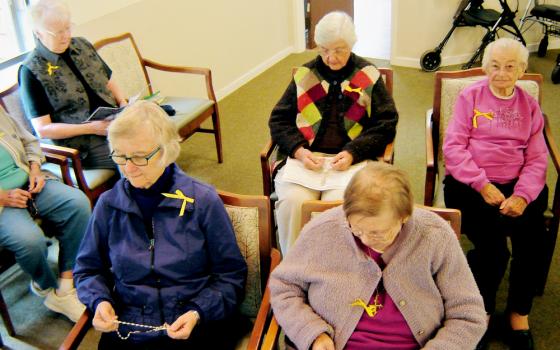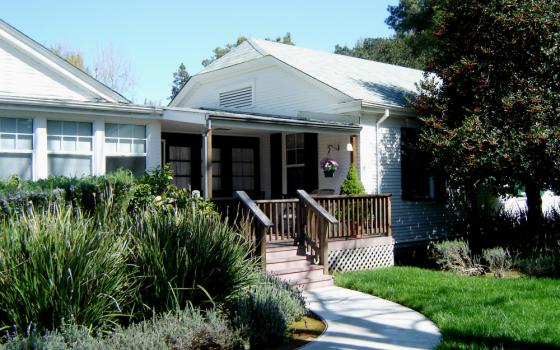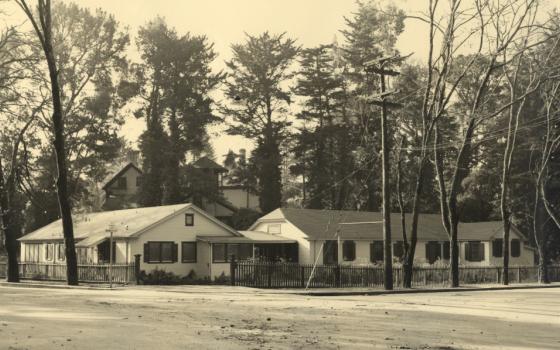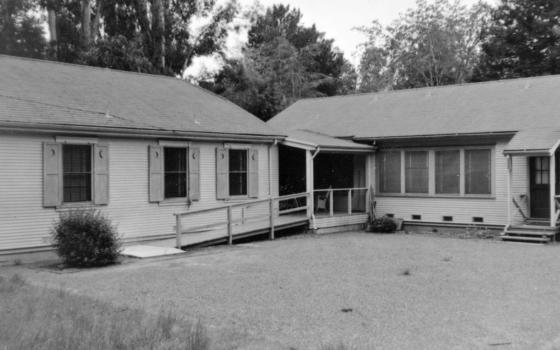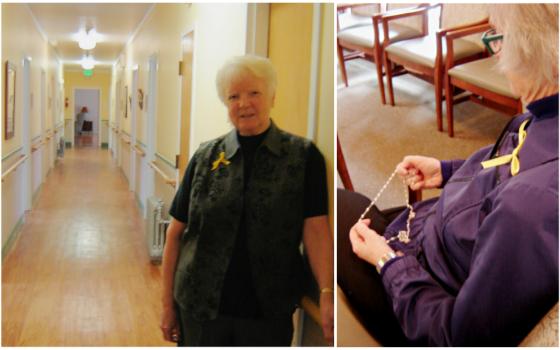Several Dominican Sisters at Lourdes Convent in San Rafael, California, wear small yellow ribbons on their lapels to show their commitment to converting their convent's yellow-walled corridor of bedrooms into a temporary housing unit for two women who are homeless and their young children.
But their plan, which they said they developed after prayerful discernment about how to respond to Pope Francis' call for mercy, is stalled by legal appeals filed by the convent's next-door neighbor, attorney Christopher Dolan.
Dolan, head of a 15-lawyer personal injury firm in San Francisco, contends that providing a temporary-use permit for the conversion violates the city's zoning laws and should not be allowed. So far, city officials disagree.
The city's interim zoning administrator approved a temporary-use permit in January. Dolan and another neighbor filed appeals to the city's Planning Commission, which rejected their appeals in a 6-0 vote March 14.
Other neighbors, advocates for people who are homeless, and some of the 30 sisters who attended the hearing testified in favor of the plan.
Sr. Patricia Simpson, administrator at Lourdes, told the commission that the request flows from the community's vision statement "affirming the inherent dignity of each human person while working for transformation of attitudes and systems that deprive any person of dignity. ... We can do no less than offer our space to those who are working to pull their lives together."
Interim Zoning Administrator Paul Jensen wrote in his staff report, "Given that the [sisters'] proposal maintains the basic residential use of the yellow hallway area, is limited in size and would not result in any expansion to or substantial physical changes to the property, a property rezoning or amendment ... is not warranted," according to the Marin Independent Journal.
The newspaper also reported that Gerald Belletto of the Planning Commission called the proposed project "a great opportunity for the women and children who would be housed there." He noted that Lourdes formerly housed many more people than what the sisters are now requesting, which is for two mothers and up to four children under 8 years old to live there for up to two years.
On March 21, Dolan filed another appeal, this time with the City Council, which is expected to take up the matter in mid-May. Should that appeal fail, Dolan could file a lawsuit against the city of San Rafael.
In response to the latest appeal, Kate Martin, director of development and communication for the Dominican Sisters of San Rafael, said the community will continue to move forward in the process.
The sisters purchased what is now Lourdes Convent in 1903 to use as an infirmary for students at what is now Dominican University of California. Over the decades, the white one-story clapboard building with green shutters moved to various sites on the campus and served as an infirmary for students at the convent's boarding school as well as the college.
The building was split into two in the 1960s, and the portion that became Lourdes was moved to its current site across the street from the congregation's administrative center and the Dominican University campus. In 1979, two wings were added to accommodate the long-term housing needs of retired sisters who needed additional care.
Currently, Lourdes Convent provides assisted-living care to 15 sisters. To accommodate the two single mothers and their children, the sisters living in the yellow wing would be moved to rooms in another wing. The vacant section would be closed off from the rest of the facility; a small eat-in kitchen would be installed and an outside entry door built.
The women would be clients of Homeward Bound, the primary provider of shelters and services for families and individuals without homes in Marin County, of which San Rafael is the county seat. Homeward Bound will select the two women for Lourdes only after all the legal issues have been resolved.
The Dominican Sisters are active partners with the agency and were a major financial contributor to the recently opened Oma Village, a supportive housing program of 14 small rental homes for families that are homeless in neighboring Novato.
Offering hospitality within their own convents is not new for the sisters in San Rafael. During the 1980s, when Central Americans fled to the United States because of civil wars in their countries, the sisters shared a portion of their motherhouse convent with a family from El Salvador. They were the first women religious congregation in California to join the sanctuary movement. The family's two children attended St. Rafael and San Domenico Schools, and the family remained with the sisters until the historic convent, built in 1889, was destroyed by a fire in 1990.
Before the zoning administrator reviewed the current proposal, Sr. Maureen McInerney, prioress of the Dominican Sisters of San Rafael, sent letters to and held meetings with neighbors. It was important, she said, for people to express their concerns about how the temporary change might affect their neighborhood. Some worried about additional traffic, and others feared the women would have visitors involved in drugs and alcohol abuse.
She assured them the women and their children would continue to participate in Homeward Bound and be required to meet all the behavioral conditions of their stay at Lourdes.
While they await the families' arrival, the sisters continue to pray for their potential yellow-hall housemates. Six candles, representing the women and their four children, sit on a credenza next to a statue of Our Lady of Lourdes. And the sisters continue to talk about their desire to tutor the children, host picnics with the two families in the convent's flower-filled courtyard, and enjoy the vibrancy young life will bring to their home.
It is, for them, an ideal way to share their resources and remain engaged in ministry. Ultimately, Simpson said, they hope Lourdes will be a "simple place that offers healing, comfort and peace."
[Monica Clark is NCR West Coast correspondent. Her email address is [email protected].]
